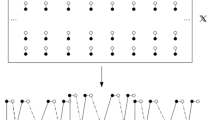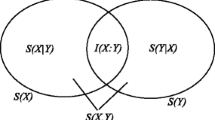Summary
A local hidden-variable theory is possible in view of quantum mechanicsonly if it satisfies bilinearity, symmetry and rotational invariance. If, however, a local hidden-variable theory satisfies all these algebraic properties, then Bell’s inequalities are not theorems of this theory. Therefore, violation of Bell’s inequalities by quantum mechanics is inconsequential for locality.
Similar content being viewed by others
References
Y. Koç:Linearity and Local Hidden Variable Theories, ISS/Ph 89-02, Boğaziçi University, Istanbul, Turkey.
Y. Koç:Bilinearity, Quantum Mechanics and Local Hidden Variable Theories, ISS/Ph 89-04, Boğaziçi University, Istanbul, Turkey.
Y. Koç:Local Hidden Variable Theories and «Bell’s theorem»: A Reconsideration, ISS/Ph 90-01, Boğaziçi University, Istanbul, Turkey.
In the present paper, the term «spin expectation value function» indicates that of two correlated particles.
Bell (ref. [6,7]) does not consider these algebraic properties.
J. S. Bell:Physics,1, 195 (1964).
J. S. Bell:Introduction to the hidden variable question, inFoundations of Quantum Mechanics, edited byB. D’Espagnat (Academic Press, 1971), p. 171.
In the present paper, we consider only [7]; however, our arguments can be restated with regard to [6] as well.
These averages are taken over the variable λ.
The function\(\bar A \bar B\) is the product of the factorized, functions\(\bar A\) and\(\bar B\) in eq. (1).
In the present paper,R 3 denotes the three-dimensional Euclidean space andR denotes the class of real numbers.
Bell’s inequality is a theorem of a local hidden variable theory if, and only if Bell’s inequality yields a true statement (e.g., 1≤2) forevery value of the hidden-variable expectation value functions in the inequality. Obviously, if Bell’s inequality is not a theorem ofsome local hidden-variable theory, then violation of Bell’s inequality by quantum mechanics is inconsequential for locality.
In definition 1, bilinearity appears in a restricted sense; however, that is sufficient for our purposes in the present paper.
E H denotes the expectation value function of the product of the spins of two correlated particles which are prepared in the singlet state; we therefore considerE H as a mapping fromR 3×R 3 intoR.
Let us also consider the Clauser-Horne inequality ([16], p. 528, inequality (4)). Clauser and Horne argue that Bell’s generalized inequality (BGI H ) is a corollary of their inequality (4) (please see: «First, (B2) is a corollary of (4)», p. 533, 1974). Theorem 1 and the lemma, however, entail that no inequality (e.g., Clauser-Horne inequality) which implies Bell’s generalized inequality (BGI H ) as a corollary can be a theorem of a local stochastic hidden-variable theory which statisfies bilinearity, symmetry and rotational invariance.
J. F. Clauser andM. A. Horne:Phys. Rev. D,10, 526 (1974).
Author information
Authors and Affiliations
Rights and permissions
About this article
Cite this article
Koç, Y. The local expectation value function and Bell’s inequalities. Nuov Cim B 107, 961–971 (1992). https://doi.org/10.1007/BF02899297
Received:
Accepted:
Published:
Issue Date:
DOI: https://doi.org/10.1007/BF02899297




